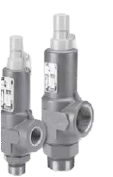Safety Relief Valve
Safety relief valves (SRVs) are critical components in various industries, designed to protect pressure systems from exceeding safe operating limits. These valves automatically open when pressure reaches a predetermined set point, releasing excess fluid or gas to prevent catastrophic failures. SRVs are essential for ensuring the safety of personnel and equipment.
Common types of SRVs include spring-loaded, pilot-operated, and rupture discs. Spring-loaded SRVs utilize a spring mechanism to regulate opening pressure, while pilot-operated valves employ a secondary pilot valve to control the main valve's operation. Rupture discs, on the other hand, function by rupturing at a specific pressure, providing a fail-safe mechanism.
SRVs find widespread application in various industries, including:
- Chemical Processing: Protecting reactors, storage tanks, and pipelines from overpressure.
- Oil & Gas: Safeguarding drilling rigs, pipelines, and processing plants.
- Power Generation: Preventing equipment failures in boilers, turbines, and other high-pressure systems.
- Pharmaceutical Manufacturing: Ensuring the safety of production processes involving pressurized vessels.
- Aerospace: Protecting aircraft components from excessive pressure fluctuations.
